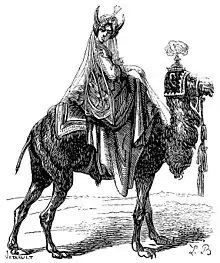Gemory
Gemory (also Gremory, Gamori, Gaeneron, Gemon, Gemyem) is a demon listed in demonological grimoires.

Description
Gemory is described in demonological works such as the Munich Manual of Demonic Magic[note 1] [1][2][3] the Liber Officiorum Spirituum[note 2][4][5] the Pseudomonarchia Daemonum,[note 3][6] the Lesser Key of Solomon,[note 4][7] the Dictionnaire Infernal,[note 3][8] as appearing in the form of a beautiful woman (though as with all Goetic demons referred to using the masculine pronouns "he" and "his") wearing a duchess's crown and riding a camel, ascribed with the power of revealing hidden treasures and answering questions about the past, present, and future.[8][1][7][4][5][6] The Munich Manual, Pseudomonarchia, Lesser Key, and Dictionnaire further give Gemory the power of procuring love from women[8][1][7][6] (although the Liber Officiorum Spirituum describes him as "a companion of the love of women, and especially of maidens"),[4][5] while the Pseudomonarchia and the Lesser Key note that the duchess's crown is (somehow) worn on Gemory's waist.[7][6] Stephen Skinner and David Rankine, in their edition of The Goetia of Dr Rudd, suggest that this was a mistranslation of the Latin cingitur which should have been translated "encircling her head".[9]
Gemory is mentioned in a manuscript labelled Fasciculus Rerum Geomanticarum.[note 1][10]
Legions and standing

In the Pseudomonarchia,[note 5] Lesser Key,[note 6] and Dictionnaire, Gemory is ranked as a duke ruling 26 legions of spirits,[7][6][8] but (still a duke) ruling 27 in the Munich Manual of Demonic Magic[note 1][1][2][3] and ruling 5 or 42 legions as either a duke,[4] prince,[5] or captain,[4][5] in the Liber Officiorium Spirituum.[note 7][4][5]
According to Rudd, Gremory is opposed by the Shemhamphorasch angel Poiel.[9]
Notes
- As Gaeneron.
- As Gemon or Gemyem.
- As Gomory.
- Some versions listing him as Gremory or Gamori.
- As the 50th spirit.
- As the 56th spirit.
- As the 41st and 75th spirits.
References
- Kieckhefer, Richard (1997). Forbidden Rites: A Necromancer's Manual of the Fifteenth Century. University Park, Pennsylvania: Pennsylvania State University Press. pp. 166, 292. ISBN 0-271-01750-3.
- Rudd, Thomas (2007). Skinner, Stephen; Rankine, David (eds.). The Goetia of Dr Rudd. Golden Hoard Press. p. 34. ISBN 073872355X.
- Weyer, Johann (1563). Peterson, Joseph H. (ed.). Pseudomonarchia Daemonum (Liber officiorum spirituum). Twilit Grotto: Esoteric Archives (published 2000). Introduction by Peterson.
- Porter, John (2011). Campbell, Colin D. (ed.). A Book of the Office of Spirits. Translated by Hockley, Frederick. Teitan Press. pp. 18, 24. ISBN 0933429258.
- Porter, John; Weston, John (2015). Harms, Daniel; Clark, James R.; Peterson, Joseph H. (eds.). The Book of Oberon: A Sourcebook for Elizabethan Magic (first ed.). Llewellyn Publications. pp. 201, 206. ISBN 978-0-7387-4334-9.
- Weyer, Johann (1563). Peterson, Joseph H. (ed.). Pseudomonarchia Daemonum (Liber officiorum spirituum). Twilit Grotto: Esoteric Archives (published 2000). par. 51.
- Peterson, Joseph H., ed. (2001). Lemegeton Clavicula Salomonis: The Lesser Key of Solomon, Detailing the Ceremonial Art of Commanding Spirits Both Good and Evil;. Maine: Weiser Books. p. 32. ISBN 1-57863-220-X.
- de Plancy, Jacques Collin (1853). Dictionnaire infernal (in French). Paris: Sagnier et Bray. p. 367.
- Rudd, Thomas (2007). Skinner, Stephen; Rankine, David (eds.). The Goetia of Dr Rudd. Golden Hoard Press. pp. 158, 374. ISBN 073872355X.
- Boudet, Jean-Patrice (2003). "Les who's who démonologiques de la Renaissance et leurs ancêtres médiévaux". Médiévales (in French) (44). Revues.org. par. 25. Cite journal requires
|journal=(help)